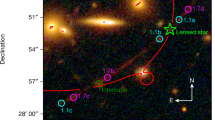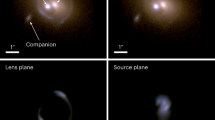Abstract
The space density of gravitational lens images as a function of redshift is calculated for various cosmological models. One cannot interpret all QSOs as gravitational lens images, unless there is a substantial amount of evolution with z in the sources of the lens images, and also a large fraction of the mass of the universe in the form of compact dark objects.
A conservative estimate, assuming no evolution of the sources, and a smoothed-out density of 7×10−31 g/cm−3, for the objects which act as lenses, results in a discrepancy by a factor ∼104 between the comoving density of lens images and QSOs, out to a redshift of z≃2.8.
This is a preview of subscription content, access via your institution
Access options
Subscribe to this journal
Receive 51 print issues and online access
$199.00 per year
only $3.90 per issue
Buy this article
- Purchase on Springer Link
- Instant access to full article PDF
Prices may be subject to local taxes which are calculated during checkout
Similar content being viewed by others
References
Zwicky, F., Phys. Rev. Ser. II, 51, 290 (1937).
Zwicky, F., Phys. Rev. Ser II, 51, 679 (1937).
Barnothy, J. M., and Barnothy, M. F., Science, 162, 348 (1968).
Refsdal, S., Mon. Not. Roy. Astron. Soc., 128, 295 (1964).
Refsdal, S., Mon. Not. Roy. Astron. Soc., 132, 101 (1966).
Liebes, S., Phys. Rev. B, 133, 835 (1964).
Innanen, K. A., Astrophys. J., 143, 153 (1966).
Fish, R. A., Astrophys. J., 139, 284 (1964).
Vaucouleurs, G. de, Ann. D'Ap., 11, 247 (1948).
Takase, B., Publ. Astron. Soc. Japan, 19, 3, 427 (1967).
Takase, B., and Kinoshita, H., Publ. Astron. Soc. Japan, 19, 3, 409 (1967).
Brandt, J. C., Astrophys. J., 131, 293 (1960).
Brandt, J. C., and Scheer, L. S., Astron. J., 70, 471 (1965).
Silva, L. N. K. de, thesis, Univ. Sussex (1970).
Silva, L. N. K. de, Nature, 228, 1180 (1970).
Schmidt, M., Astrophys. J., 162, 371 (1970).
Vaucouleurs, G. de, and Vaucouleurs, A. de, Astron. J., 73, 858 (1968).
Refsdal, S., Astrophys. J., 159, 357 (1970).
Bertotti, B., Proc. Roy. Soc., A, 269, 195 (1966).
Gunn, J. E., Astrophys. J., 147, 61 (1967).
Gunn, J. E., Astrophys. J., 150, 737 (1967).
Kantowski, R., Astrophys. J., 155, 89 (1969).
Legg, T. H., Nature, 226, 65 (1970).
Author information
Authors and Affiliations
Rights and permissions
About this article
Cite this article
SANITT, N. Quasi-stellar Objects and Gravitational Lenses. Nature 234, 199–203 (1971). https://doi.org/10.1038/234199a0
Received:
Issue Date:
DOI: https://doi.org/10.1038/234199a0
This article is cited by
-
Gravitational lensing by a non-Schwarzschild black hole in a plasma
Astrophysics and Space Science (2016)
-
Flux variations of QSO 0957 + 561 A, B and image splitting by stars near the light path
Nature (1979)
-
0957 + 561 A, B: twin quasistellar objects or gravitational lens?
Nature (1979)
Comments
By submitting a comment you agree to abide by our Terms and Community Guidelines. If you find something abusive or that does not comply with our terms or guidelines please flag it as inappropriate.



